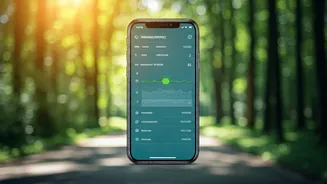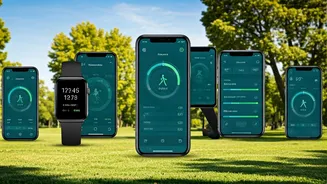Tracking Your Steps
Many walking apps excel at tracking your daily steps. These applications utilize your smartphone's built-in sensors or connect to wearable devices, such
as smartwatches or fitness trackers, to accurately record the distance you have covered. They calculate not only steps taken but also provide details like the distance traveled, the duration of the walk, and the calories burned. By providing you with real-time data and detailed statistics, these apps assist in keeping you informed about your fitness efforts. You can usually view your progress through user-friendly dashboards, which include charts and graphs to visualize your activity patterns over time, helping you to stay informed of your achievements.
Motivational Features Aplenty
Walking apps often have features designed to encourage regular physical activity. Many include gamification elements like challenges, badges, and leaderboards to keep you motivated. You might earn virtual rewards for reaching certain step goals, or you can compete against friends and family. Moreover, many apps integrate social features, allowing you to share your progress and celebrate achievements together. These social features foster a sense of community, making your exercise routine more enjoyable. Some apps also offer personalized insights and recommendations based on your activity, providing tailored encouragement and advice to help you reach your fitness objectives effectively.
Comprehensive Progress Tracking
Beyond simple step tracking, many walking apps offer detailed analysis of your activity. These apps often record additional information, such as elevation changes, pace, and the routes you have taken. Some apps even integrate with GPS to map your walks, allowing you to see where you have been and how far you've traveled. This comprehensive data enables you to monitor your fitness trends and identify areas for improvement. You can then review your stats on a daily, weekly, or monthly basis to observe your progress over time. These analytics help you better understand your activity levels, motivating you to keep pushing your boundaries and achieve consistent results. They also provide insights into your overall health.
Step-by-Step Goal Setting
Setting clear goals is a common feature in most of the best walking apps. You can set daily, weekly, or monthly step targets and then track your progress towards them. You can customize these goals based on your fitness level and aspirations, making them achievable and effective. For example, if you are new to walking, you might begin with a modest goal of 5,000 steps per day and gradually increase it. Most apps also offer reminders and prompts to help you stay on track, ensuring that you don't miss your target. These reminders serve as gentle nudges, encouraging you to step outside and be active. They make it easier to incorporate walking into your daily routine and remain committed to your fitness objectives.
Apps for Diverse Needs
The top 10 walking apps cater to a wide range of needs. Whether you are aiming to lose weight, improve cardiovascular health, or just get moving, there's an app for you. Some apps focus on detailed tracking with advanced analytics, whereas others concentrate on motivation through gamification and social interaction. Some are completely free, while others offer premium features through a subscription service. These premium features may include advanced insights, personalized coaching, or exclusive challenges. Before selecting an app, it's wise to consider your individual preferences and fitness goals. You might like an app that offers guided walks or integrates with other health platforms. This will help you select the one that will become an essential part of your daily routine.
User-Friendly Interfaces
Ease of use is crucial in selecting a walking app. The best apps feature intuitive interfaces that are simple to navigate and understand. The main functions, such as step tracking, progress monitoring, and goal setting, should be easily accessible. The design needs to be clean and clutter-free, providing clear and concise information. The dashboard should present important metrics in a visual manner, making it easy to track your performance. A good app should also sync seamlessly with other devices and platforms, allowing you to access your data from anywhere. Ultimately, a user-friendly app will enhance your experience, encouraging you to stay consistent and make the most of your walking routine.
Social and Community Elements
The social aspect of many walking apps is a powerful motivator. Many apps allow you to connect with friends, family, or other users to share progress and offer encouragement. You can participate in challenges together, compete on leaderboards, and celebrate achievements collectively. Sharing your fitness journey with others provides a sense of accountability and support, making it easier to stay committed to your goals. You can also gain inspiration from seeing the progress of others and learn new strategies to make your walks more enjoyable and effective. This supportive community environment promotes a positive atmosphere, helping you stick with your fitness routine and fostering a sense of camaraderie.
Integration with Other Devices
The ability to integrate with other devices and health platforms improves the functionality of many walking apps. Many apps sync with wearable devices, such as smartwatches and fitness trackers, to provide accurate step tracking and additional data. This integration allows you to gather comprehensive health information in one place, enabling a more holistic view of your health. You can see your step counts, heart rate, sleep patterns, and other health metrics all in one place. Additionally, the apps may integrate with platforms like Apple Health or Google Fit, allowing you to sync your data with other health and fitness applications. This feature ensures that you have a complete picture of your health.
Battery Life Considerations
When selecting a walking app, it is important to think about its impact on your smartphone’s battery life. Some apps use more battery than others, particularly those with GPS tracking or other intensive features. Before you commit to a specific app, try a few test walks to see how it affects your phone’s battery. Consider turning off unnecessary features, such as background data refresh, to extend battery life. Some apps allow you to adjust settings to optimize battery usage, such as reducing the frequency of data syncing. The goal is to balance the app's functionality with your smartphone's battery capacity to guarantee that you can enjoy your walks without worrying about your device dying prematurely.
Stay Consistent, Stay Active
Using the right walking app can make exercise more enjoyable and effective. The key is to find an app that aligns with your individual preferences, fitness objectives, and lifestyle. By leveraging the features of these apps, you can easily track your progress, stay motivated, and make walking a consistent part of your routine. Remember to set realistic goals, celebrate your successes, and have fun. The best results come from staying consistent and making walking a sustainable habit. As you gradually increase your step count and incorporate regular walks into your day, you will likely experience improvements in your overall fitness and well-being. So, lace up those shoes, download an app, and start stepping towards a healthier you.












